
In the introductory article I spoke in general about the potential of cannabis in the medical field, and the necessary substances are extracted from the apical part of the plant.
And can the remaining part of the plant have a specific use?
Certainly!
Every part of the plant can have a specific use, especially in the construction of buildings and clothing.
The stem
The stem, or the structure of the plant, offers the possibility of obtaining two different products from its respective parts: fibres from the outer part and canapulo from the woody inner part.
The fibres can mainly be used to obtain yarns for textiles, bioplastics, paper and in some cases to replace synthetic fibres for the restoration of structures; here are some Italian examples of fibre applications in the textile sector
https://www.maekotessuti.com/eng/hemp/
https://www.altramoda.net/en/material/79102
Hemp is used in the building industry as an insulator.
Hemp in construction
The use of hemp in construction has brought enormous benefits, especially in relation to pollution.
The processing of this plant to obtain raw materials for the construction of building components has a really low environmental impact; we could even consider that hemp, from its birth until its use in construction, does not produce CO2, but transforms it thanks to photosynthesis.
As mentioned above, hemp stalk and fibres are obtained from the plant; these materials have two different uses in the building industry.
Canapulo
The inner part, reduced to shavings, has very high hygroscopic and insulating capacities; together with lime it can be used to make bricks, screeds and fill cavities as insulation.
The lightness of this material makes it suitable for the construction of floor screeds as it can be an excellent substitute for lightened aggregates for lightened screeds.
Its hygroscopicity is extraordinary as the material absorbs moisture when it is high and releases it when the environment tends to be dry: a natural solution to the mould that occurs in some homes.
The insulating power, both thermal and acoustic, benefits the healthiness of the home: there is always little talk of noise pollution, and it is very important to have materials which keep noise out.
Thermal insulation has many positive effects, starting with the elimination of thermal bridges (areas in which the cold outside is transmitted to the inside of the heated environment), which are increasingly often the cause of mould in the corners of rooms, energy savings and a reduction in CO2 production.
Some images of what can be achieved with canapulo

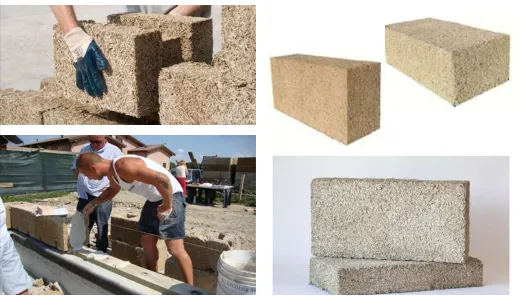
Fibre
Fibre, which is found on the outside of the canapulo, is a very valuable material as it is extremely versatile.
Because of its resistance to stresses and strains, it is used in construction for structural reinforcement.
Hemp fibre replaces carbon fibre, glass fibre and steel fibre with almost no environmental impact.
The processing of the fibre is extremely simple and in many situations does not require synthetic materials to give it additional stability.
In most cases it is possible to combine hemp fibre with potato starch or natural glues.
The process of constructing the panels is quite simple: when the fibre is ready with the decided binder, all that needs to be done is to press it at a high temperature.
The panels thus obtained can be used to make insulating coats (internal or external) and insulating panels for attics.
It is also possible to obtain plaster nets (shaving nets).
Here are some examples of building components obtained with hemp fibre
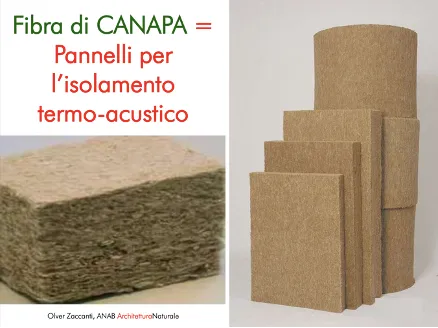
HEMP fibre = Panels for thermo-acoustic insulation
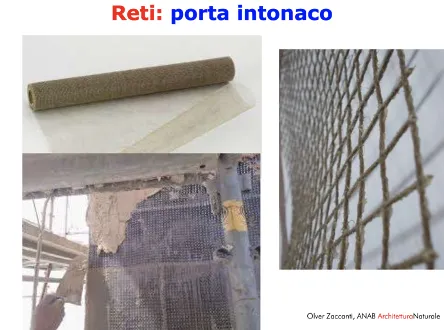
Nets: plaster holder
Processing
Another extremely important aspect of hemp is the environmental impact of processing the raw material to obtain the various derivatives.
In the diagram below, two very significant figures are immediately apparent: the negative value on CO2 production and the amount of water required for the production chain, which is the lowest of all the cases examined.
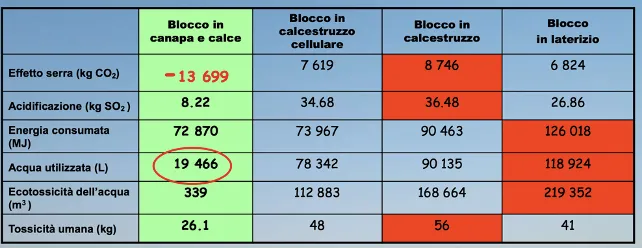
Conclusions
As we have seen, hemp, thanks to its intrinsic properties, is widely used in construction.
But it is not only theory, there are many buildings made with this material and the functional characteristics are really first class.
The buildings are all over Europe, the most famous being in Italy and France.
In Italy, houses have been built with 90% European funding because of the extraordinary seismic resistance of the structure.
In 2012, following the earthquake in Emilia-Romagna, which reached 6° on the Richter scale, a house built a few years earlier did not suffer any surface or structural damage.
This resistance is mainly due to the elasticity of the structure, which is completely made of wood, and the hemp and lime brick infill.

Housing built in San Giovanni in Persiceto in Bologna – Italy
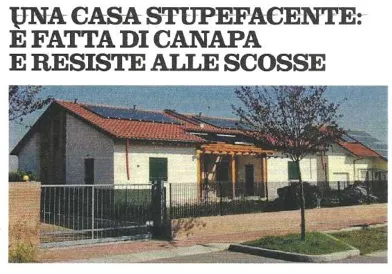
"An amazing house is made of hemp and resists shocks"
In Bisceglie, Apulia, an entire building with 40 residential units and commercial spaces has been constructed.
Below is a photograph

Here are some European constructions
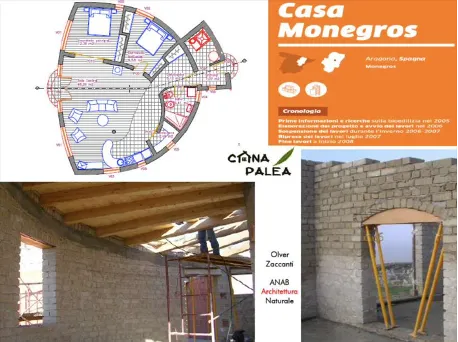
ARAGON - SPAIN

PENKER - FRANCE
This type of construction is having a great response for the thermal characteristics of hemp.
In the photo below we can see how at an outside temperature of 35°, inside the house we can have 22° without any cooling equipment activated.

The extraordinary insulating power of this material can be seen in the graph below: the internal temperature: the graph is quite clear and immediately gives us an idea of the efficiency of hemp as an insulator: the thermal delta settles in a handful of degrees centigrade even in rather significant temperature ranges (between 19 and 20 May we have a range of almost 10°!
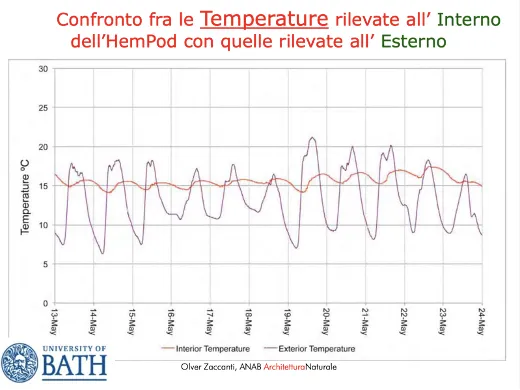
The same applies to humidity. In the graph below we can see how the relative humidity is maintained inside the house.
And that's not all.
The range is also lower than the standards for a healthy environment: 60% is the limit prescribed, while it remains between 55 and 58%.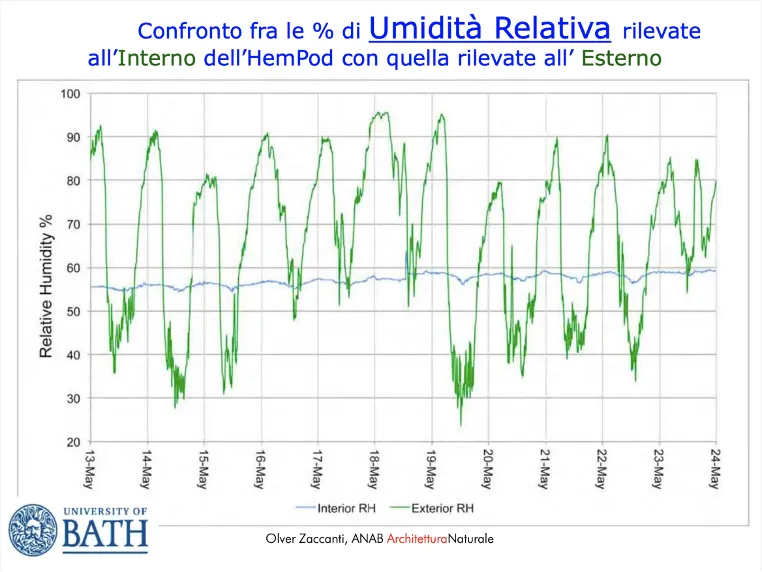
@ganjafarmer , @canna-curate, @weedcash Let me know your thoughts about!

Nell'articolo introduttivo ho parlato in generale delle potenzialità della cannabis in ambito medico e le sostanze necessarie si estraggono dalla parte apicale della pianta.
E la restante parte di pianta può avere un utilizzo specifico?
Certamente!
Ogni parte della pianta può avere un preciso impiego, soprattutto nell’ambito delle costruzioni di edifici ed abbigliamento.
Il gambo
Il gambo o struttura della pianta, offre la possibilità di ottenere due diversi prodotti dalle rispettive parti che lo compongono: dalla parte esterna le fibre, mentre dalla parte interna, legnosa, il canapulo.
Con le fibre si possono ottenere principalmente filati per l’ambito tessile, bioplastiche, carta e in alcuni casi sostituire le fibre sintetiche per il risanamento di strutture; di seguito alcuni esempi italiani di applicazioni della fibra in ambito tessile
https://www.maekotessuti.com/eng/hemp/
https://www.altramoda.net/en/material/79102
Il canapulo invece, trova applicazione in ambiente edilizio come isolante.
Canapa in edilizia
L’utilizzo della canapa nell’edilizia ha portato enorme giovamento soprattutto in relazione all’inquinamento.
La lavorazione di questa pianta per ottenere le materie prime utili alla costruzione dei componenti edili ha un impatto ambientale realmente basso; potremmo addirittura considerare che la canapa, dalla sua nascita fino all’utilizzo edile non produce CO2, bensì la trasforma grazie alla fotosintesi clorofilliana.
Come detto poco sopra, dal gambo della pianta si ottengono il canapulo e le fibre; questi materiali hanno due differenti destinazioni in ambito edilizio.
Canapulo
La parte interna, ridotta in trucioli, ha grandissime capacità igroscopiche ed isolanti, assieme alla calce si possono creare mattoni, massetti e riempimento di intercapedini come coibentazione.
La leggerezza di questo materiale lo rende idoneo alla costruzione di massetti per pavimentazioni in quanto può sostituire egregiamente gli inerti alleggeriti per massetti alleggeriti.
L’igroscopicità è straordinaria in quanto il materiale assorbe umidità quando è alta e la rilascia quando l’ambiente tende ad essere secco: una soluzione naturale alla muffa che si manifesta in alcune abitazioni.
Il potere isolante, sia termico che acustico giova alla salubrità delle abitazioni: si parla sempre poco dell’inquinamento acustico, e avere dei materiali che consentono di tenere all’esterno i rumori è molto importante.
L’isolamento termico ha molteplici risvolti positivi, a partire dall’eliminazione dei ponti termici (zone in cui il freddo esterno viene trasmesso all’interno dell’ambiente riscaldato) causa sempre più spesso di creare muffe negli angli delle stanze, al risparmio energetico e un abbassamento della produzione di CO2.
Alcune immagini di quello che si può ottenere dal canapulo


Fibra
La fibra, che si trova esternamente al canapulo è una materia molto pregiata in quanto estremamente versatile.
Vista la sua resistenza a sforzi e tensioni, nelle costruzioni trova la sua collocazione nei ripristini o rinforzi strutturali.
La fibra della canapa prende il posto della fibra di carbonio, fibra di vetro e fibra di acciaio con un impatto ambientale pressochè nullo.
La lavorazione della fibra è estremamente semplice e in molte situazioni non necessita di materiali sintetici per conferirle ulteriore stabilità.
Nella maggior parte dei casi è possibile combinare la fibra della canapa con amido di patate o colle naturali.
Il procedimento di costruzione dei pannelli è piuttosto semplice, infatti, quando la fibra è pronta con il legante deciso, non occorre fare altro che pressare il tutto ad alta temperatura.
Con i pannelli così ottenuti si possono eseguire cappotti coibentanti (interni od esterni) e pannelli isolanti per sottotetti.
Si possono inoltre ottenere delle reti porta intonaco (rete rasatura)
Di seguito alcuni esempi di componenti edilizi ottenuti con la fibra della canapa


Lavorazione
Altro aspetto estremamente importante della canapa è l’impatto ambientale che ha la lavorazione della materia prima per ottenere i vari derivati.
Nello schema sotto sono immediati due dati molto significativi: il valore negativo sulla produzione di CO2 e la quantità di acqua necessaria alla filiera di produzione, che è il minore di tutte le casistiche prese in esame.

Conclusioni
Come abbiamo visto la canapa, grazie alle sue proprietà intrinseche trova un largo utilizzo in ambito edilizio.
Ma non è solamente teoria, ci sono molteplici edifici realizzati con questo materiale e le caratteristiche funzionali sono realmente di prim’ordine.
Le costruzioni interessano tutta Europa, le più rinomate sono in Italia e Francia.
In Italia sono state costruite delle villette finanziate al 90% con fondi Europei in merito alla straordinaria resistenza sismica della struttura.
Relativamente a questo aspetto occorre fare una precisazione: nel 2012, a seguito del terremoto in Emilia-Romagna, che ha toccato il 6° della scala Richter, un’abitazione costruita alcuni anni prima non ha riportato alcun danno sia superficiale che strutturale.
Questa resistenza è dovuta principalmente all’elasticità della struttura che è completamente in legno che dalle tamponature in mattoni di canapa e calce.
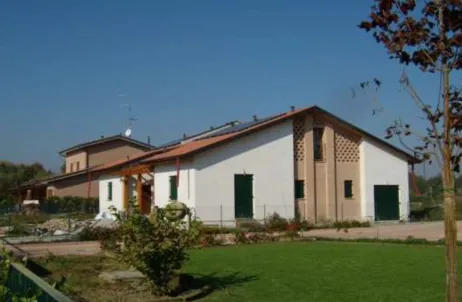
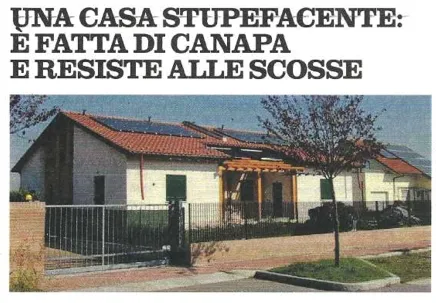
Le abitazioni costruite a San Giovanni in Persiceto a Bologna - Italia
In Puglia a Bisceglie è stato costruito un intero edificio con 40 unità abitative e spazi commerciali.
Di seguito una fotografia

Di seguito alcune costruzioni in ambito europeo

ARAGONA – SPAGNA

PENKER – FRANCIA
Questa tipologia costruttiva sta avendo un grande responso per le caratteristiche termiche della canapa.
Nella foto sotto possiamo vedere, come alla temperatura esterna di 35°, all’interno dell’abitazione possiamo avere 22° senza alcuna apparecchiatura di raffrescamento attivata.

Lo straordinario potere isolante di questo materiale lo possiamo vedere nel grafico sottostante: la temperatura interna: il grafico è piuttosto chiaro e ci dà immediatamente idea dell’efficienza della canapa come isolante: il delta termico si assesta in una manciata di gradi centigradi anche in escursioni termiche piuttosto importanti (tra il 19 e il 20 maggio abbiamo un’escursione di quasi 10°!

Stesso discorso vale per l’umidità, nel grafico sotto possiamo apprezzare come viene mantenuta l’umidità relativa all’interno dell’abitazione.
Non solo.
Il range è anche inferiore a quanto prescrivono le normative per un ambiente salubre: infatti prescrivo-no il 60%, mentre rimane compresa tra il 55 e il 58%.

